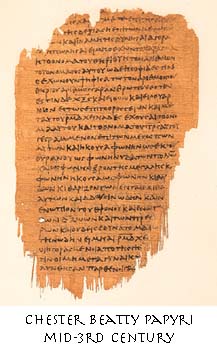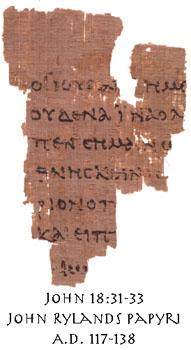Editor's Note:
The eighth Article of Faith in The Church of Jesus Christ of Latter-day Saints states in part, "We believe the Bible to be the word of God as far as it is translated correctly..."
Notwithstanding this official declaration, the LDS Church in fact promotes the idea that the Bible we have today is not trustworthy. Maintaining that the Bible has been corrupted through the machinations of wicked men, the LDS Church teaches members that it is incomplete and inaccurate.
While many examples of this doctrine could be cited,* consider the following statement by Orson Pratt, an early Apostle of the LDS Church:
What shall we say then, concerning the Bible's being a sufficient guide? Can we rely upon it in its present known corrupted state, as being a faithful record of God's word? We all know that but a few of the inspired writings have descended to our times,...What few have come down to our day have been mutilated, changed, and corrupted, in such a shameful manner that no two manuscripts agree....Add all this imperfection to the uncertainty of the translation, and who, in his right mind, could, for one moment, suppose the Bible in its present form to be a perfect guide? Who knows that even one verse of the whole Bible has escaped pollution, so as to convey the same sense now that it did in the original?" (Orson Pratt, Divine Authenticity of the Book of Mormon, 47)
The following article by Greg Koukl speaks to these accusations. As you will learn, we can place unreserved confidence in the New Testament and its reliability. -SAL
*For more information about LDS teachings concerning the Bible please see We Believe the Bible...?
Dear Friend,
"The Bible has been changed and translated so many times over the last 2000 years, it's impossible to have any confidence in its accuracy. Everyone knows that."
This invocation of common knowledge is enough to satisfy the ordinary, man-on-the-street critic of the New Testament, and the challenge has stopped countless Christians in their tracks. But it's remarkably easy to answer if you know a few simple details.
The complaint is understandable. Whisper a message from person to person, then compare the message's final form with the original. The radical transformation in so short a period of time is enough to convince the casual skeptic that the New Testament documents are equally unreliable.

How can we know the documents we have in our possession correctly reflect originals destroyed two millennia ago? Communication is never perfect. People make mistakes. Errors are compounded with each generation. After 2000 years of copying, recopying, translating, and copying some more, it's anyone's guess what the original said.
It's easy to state the problem, and some may think that merely raising the objection makes the argument compelling. Yet offering concrete evidence is a bit more difficult. Usually the complaint is raised by people who have little understanding of the real issues.
In cases like this, an appeal to common knowledge is often an appeal to common ignorance; the people don't have reliable information.
The question of the authenticity of the New Testament is not really a religious question; it is an academic one.
It can be answered without any reference to personal "faith." Instead, all that's needed is a simple appeal to facts, a little technique I call "Just the facts, Ma'am."
Just the Facts, Ma'am
It's hard to imagine how one can reconstruct an original after 2000 years of copying, recopying, and translating. The skepticism, though, is based on two misconceptions about the textual history of ancient documents like the New Testament.
The first assumption is that the transmission is more or less linear -- one person telling a second who talks with a third, etc., leaving a single message many generations removed from the original. Second, the objection assumes oral transmission which is more easily distorted and misconstrued than something written.
Neither assumption applies to the text of the New Testament. First, the transmission was not linear, but geometric -- e.g., one letter birthed 50 copies which generated 500 and so on. Secondly, the transmission was done in writing, and written manuscripts can be tested in a way oral communications cannot.
Reconstructing Aunt Sally's Letter
Let me illustrate how such a test can be made. It will help you to see how scholars confidently reconstruct an original from existing manuscript copies even though the copies have differences and are much younger than the autograph.
Pretend your Aunt Sally learns in a dream the recipe for an elixir that preserves her youth. When she wakes up, she scribbles the directions on a scrap of paper, then runs into the kitchen to make up her first glass. In a few days Aunt Sally is transformed into a picture of radiant youth because of her daily dose of "Sally's Secret Sauce."

Aunt Sally is so excited she sends detailed, hand-written instructions on how to make the sauce to her three bridge partners (Aunt Sally is still in the technological dark ages -- no photocopier or email). They, in turn, make copies for ten of their own friends.
All goes well until one day Aunt Sally's pet schnauzer eats the original copy of the recipe. In a panic, she contacts her three friends who have mysteriously suffered similar mishaps, so the alarm goes out to the others in attempt to recover the original wording.
Sally rounds up all the surviving hand-written copies, twenty-six in all. When she spreads them out on the kitchen table, she immediately notices some differences. Twenty-three of the copies are exactly the same. Of the remaining three, however, one has misspelled words, another has two phrases inverted ("mix then chop" instead of "chop then mix") and one includes an ingredient none of the others has on its list.
Do you think Aunt Sally can accurately reconstruct her original recipe from this evidence? Of course she can. The misspellings are obvious errors. The single inverted phrase stands out and can easily be repaired. Sally would then strike the extra ingredient reasoning it's more plausible one person would add an item in error than 25 people would accidentally omit it.
Even if the variations were more numerous or more diverse, the original could still be reconstructed with a high level of confidence if Sally had enough copies.
This, in simplified form, is how scholars do "textual criticism," an academic method used to test all documents of antiquity, not just religious texts. It's not a haphazard effort based on hopes and guesses; it's a careful linguistic process allowing an alert critic to determine the extent of possible corruption of any work.
How Many and How Old?
Success depends on two factors. First, how many copies exist? Second, how old are the manuscripts?
If the numbers are few and the time gap wide between the original and the oldest copy, the autograph is harder to reconstruct. However, if there are many copies and the oldest are reasonably close in time to the original, the scholar can be more confident she's pinpointed the exact wording of the initial manuscript.
To get an idea of the significance of the New Testament manuscript evidence, note for a moment the record for non-biblical texts. These are secular texts from antiquity that have been reconstructed with a high degree of certainty based on available textual evidence.
Josephus' First Century document The Jewish War survives in only nine complete manuscripts dating from the 5th Century -- four centuries after they were written.1 Tacitus' Annals of Imperial Rome is one of the chief historical sources for the Roman world of New Testament times, yet, surprisingly, it survives in partial form in only two manuscripts dating from the Middle Ages.2 Thucydides' History survives in eight copies. There are 10 copies of Ceasar's Gallic Wars, eight copies of Herodotus' History, and seven copies of Plato, all dated over a millennium from the original. Homer's Iliad has the most impressive manuscript evidence for any secular work with 647 existing copies.3
Note that for most documents of antiquity only a handful of manuscripts exist, some facing a time gap of 800-2000 years or more. Yet scholars are confident they have reconstructed the originals with a high degree of accuracy. In fact, virtually all of our knowledge of ancient history depends on documents like these.
The Biblical Manuscript Evidence
The manuscript evidence for the New Testament is stunning by comparison. The most recent count (1980) shows 5,366 separate Greek manuscripts. These are represented by early fragments, uncial codes (manuscripts in capital Greek letters bound together in book form), and minuscules (small Greek letters in cursive style).4

Among the nearly 3,000 minuscule fragments are 34 complete New Testaments dating from the 9th to the 15th Centuries.5
Uncial manuscripts providing virtually complete New Testaments date back to the 4th Century and earlier. Codex Sinaiticus is dated c. 340.6 The near complete Codex Vaticanus is the oldest, dated c. 325-350.7 Codex Alexandrinus contains the whole Old Testament and a nearly complete New Testament and dates from the late 4th Century to the early 5th Century.
The most fascinating evidence comes from the fragments. The Chester Beatty Papyri contains most of the New Testament and is dated mid-3rd Century.8 The Bodmer Papyri II collection, whose discovery was announced in 1956, includes the firt fourteen chapters of the Gospel of John and much of the last seven chapters. It dates from A.D. 200 or earlier.9
The most amazing find of all, however, is a small portion of John 18:31-33, discovered in Egypt. Known as the John Rylands Papyri and barely three inches square, it represents the earliest known copy of any part of the New Testament. The papyri is dated on paleographical grounds at A.D. 117-138 (though it may even be earlier),10 showing that the Gospel of John was circulated as far away as Egypt within 40 years of it's composition.
Keep in mind that most papyri are fragmentary. Only about 50 manuscripts contain the entire New Testament. Even so, the manuscript textual evidence is exceedingly rich, especially when compared to other works of antiquity.
Ancient Versions and Patristic Quotations
Tow other cross-checks on the accuracy of the manuscripts remain: ancient versions and citations by early church Fathers known as patristic quotations.
Early in the history of the Church, the Scriptures were translated into Latin. By the 3rd and 4th Centuries the New Testament had been translated into Coptic, Syriac, Armenian, and Georgian, among others. These texts helped missionaries reach new cultures in their own language as the Gospel spread and the Church grew.11 Translations of the Greek manuscripts (called "versions") help modern-day scholars answer questions about the underlying Greek manuscripts.
In addition, there are ancient extra-biblical sources -- catechisms, lectionaries, and quotes from the church fathers -- that cite Scripture at great length. Bruce Metzger notes, amazingly, that "if all other sources for our knowledge of the text of the New Testament were destroyed, [the patristic quotations] would be sufficient alon for the reconstruction of practically the entire New Testament.12
The Verdict
What can we conclude from this evidence? Professor Daniel Wallace notes that although there are about 300,000 individual variations of the New Testament, this number is very misleading. Most of the differences are completely inconsequential -- spelling errors, inverted prhases and the like. A side-by-side comparison between the two main text families (the Majority Text and the modern critical text) shows agreement a full 98% of the time.13
Of the remaining differences, virtually all yield to vigerous textual criticism. This means that our New Testament is 99.5% textually pure. In the entire text of 20,000 lines, only 40 lines are in doubt (about 400 words), and none affects any significant doctrine.14
Scholar D.A. Carson sums it up this way: "The purity of text is of such a substantial nature that nothing we believe to be true, and nothing we are commanded to do, is in any way jeopardized by the variants."15
This issue is no longer contested by non-Christian scholars, and for good reason: If we reject the authenticity of the New Testament on textual grounds, we'd have to reject every work of antiquity and declare null every piece of historical information from written sources prior to the beginning of the second millennium, A.D.
Has the New Testament been changed? Critical, academic analysis says it has not.
Gregory Koukl
President, Stand to Reason
Reprinted from Solid Ground, January/February 2005. Used by permission of Stand to Reason.